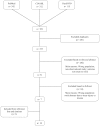Factors associated with return to work among people on work absence due to long-term neck or back pain: a narrative systematic review
- PMID: 28674139
- PMCID: PMC5734441
- DOI: 10.1136/bmjopen-2016-014939
Factors associated with return to work among people on work absence due to long-term neck or back pain: a narrative systematic review
Abstract
Objective: The purpose of this narrative systematic review was to summarise prognostic factors for return to work (RTW) among people with long-term neck/shoulder or back pain.
Methods: A systematic literature search was performed through three databases (Medline, CINAHL and PsycINFO) for studies published until February 2016. Only observational studies of people on work absence (≥2 weeks) due to neck/shoulder or back pain were included. The methodological quality of the included studies was assessed using guidelines for assessing quality in prognostic studies on the basis of Framework of Potential Biases. Factors found in the included studies were grouped into categories based on similarities and then labelled according to the aspects covered by the factors in the category.
Results: Nine longitudinal prospective cohort studies and one retrospective study fulfilled the inclusion criteria. From these, five categories of factors were extracted. Our findings indicate that recovery beliefs, health-related factors and work capacity are important for RTW among people with long-term neck or back pain. We did not find support for workplace factors and behaviour being predictive of RTW.
Conclusions: Our findings suggest that recovery beliefs, perceived health and work capacity may be important targets of intervention for people with long-term neck or back pain. However, more high-quality prospective studies are needed to confirm the results and improve our understanding of what is needed to facilitate RTW in this population.
Keywords: musculoskeletal; prognostic factors; sick leave; work ability.
© Article author(s) (or their employer(s) unless otherwise stated in the text of the article) 2017. All rights reserved. No commercial use is permitted unless otherwise expressly granted.
Conflict of interest statement
Competing interests: None declared.
Figures
References
-
- Frank JW, Brooker AS, DeMaio SE, et al. . Disability resulting from occupational low back pain. Part II: what do we know about secondary prevention? A review of the scientific evidence on prevention after disability begins. Spine 1996;21:2918–29. - PubMed
-
- Alexanderson K. Sickness absence: a review of performed studies with focused on levels of exposures and theories utilized. Scand J Soc Med 1998;26:241–9. - PubMed
Publication types
MeSH terms
LinkOut - more resources
Full Text Sources
Other Literature Sources
Medical

